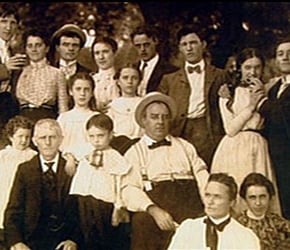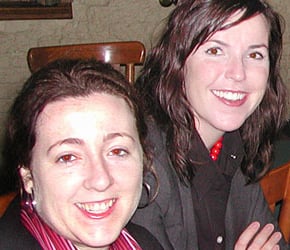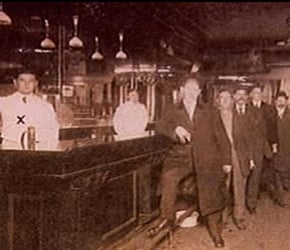![]()
Host Aidan Quinn
Born in Chicago, Aidan started his acting career on the Chicago stage and went on to play the title role in... READ BIO
Past, Present, Future
Politics
In the 1930's and 1940's, Irish-American politicians were poised to take over the mayoralty. Of the city's forty-five mayors in the city's first one hundred years, three had been Irish-American. Over the next half century, four of the five mayors who held office would be of Irish descent.
Richard J. Daley became mayor in 1955 and remained in office until his death 21 years later in 1976. He oversaw a prosperous, postwar city. It was an era of change, of modernization, a time of expressways and skyscrapers, and the building of new institutions. Other legendary Irish politicians include "Honest John" Comiskey (father of White Sox owner Charles Comiskey), "Hinky Dink" Kenna, "Bathhouse John" Coughlin, "Foxy Ed" Cullerton, and Johnny Powers (the nemesis of social reformer Jane Addams). SOURCE: Chicago's Irish and the Encyclopedia of Chicago.
Parishes
While politics and nationalism contributed to the high profile of Chicago's Irish, these tended to be male-dominated activities. The Catholic Church, on the other hand, with its extensive networks of parishes, schools, hospitals, and charitable institutions, directly affected and involved the lives of thousands of Irish women and children as well as adult men.
William Quarter, the first of nine bishops of Irish birth or descent to head the Chicago diocese since 1843, regarded Catholic institutions as essential to the well-being of immigrants and the larger city. At the same time he organized St. Patrick's for the Irish in 1846, he founded St. Peter's and St. Joseph's for the city's Germans. A pragmatic response to ethnic diversity, national-language and territorial parishes became distinguishing features of Chicago Catholicism.
However, for the vast majority of Chicago's Irish, estimated at nearly 300,000 by 1890, parishes remained the focal point of their lives and their neighborhoods. Staffed by priests and nuns of Irish birth and descent, these parishes played a vital role in mediating tensions between ethnic, Catholic, and American identities. While early Irish parishes were overwhelmingly working-class, by the 1880s middle-class parishes flourished in outlying neighborhoods such as Lincoln Park, Lake View, Oakland, Hyde Park, Englewood, and Austin.
SOURCE: The Encyclopedia of Chicago.
Labor
The Irish immigrated to Chicago for a chance at greater economic opportunity. Some of their initial industries of labor included:
Illinois & Michigan Canal: Much of the work on the Illinois & Michigan Canal between 1837 and 1848 was done by hand. While canal laborers included Yankees, southerners, Native Americans, African Americans, Germans, English, and French Canadians, most were Irish immigrants. Hundreds of poor Irish men journeyed to the region to take up this backbreaking, low-wage work. Their poverty, foreignness, and Catholicism isolated them, as did the remote and often isolated construction sites.
Meatpacking: Formed at the turn of the century, the American Federation of Labor's Amalgamated Meat Cutters and Butcher Workmen of North America (AMC) was the first national organization dedicated to the unionization of the meat industry. Its founders realized that control of the nation's packinghouses, especially those in Chicago, was essential to success. Between 1900 and 1904, the AMC built a powerful organization in the Chicago plants, especially Armour and Swift. Its strongest base of support lay with the skilled "butcher aristocracy," largely comprising Irish and German workers.
Police: After 1856, the department hired many foreign-born recruits, especially unskilled but English-speaking Irish immigrants. Serving on the Chicago Police Force became a proud tradition for many Irish-American families.
Domestics: By 1870, one in five Chicago households employed domestic workers, who accounted for 60 percent of the city's wage-earning women. Over the next half century, domestic service represented the leading occupation of women in Chicago and the nation. While comparable or superior in pay to other jobs open to poor, uneducated females, domestic work attracted few native-born women because of the long hours, low status, lack of freedom, and close supervision. Consequently, domestic servants often came from the ranks of the most desperate members of the community, either those too poor to pay for housing or those excluded from other vocations. In late nineteenth-century Chicago, domestic work was increasingly performed by Irish, German, Scandinavian, and Polish women. SOURCE: Encyclopedia of Chicago
Irish Chicago is made possible through the generous support of The William F. O'Connor Foundation, in Memory of Billy O'Connor; Walsh Construction; and Robert & Joan Clifford.
Additional support is provided by Mr. & Mrs. W. James Farrell and OBriens Restaurant and Bar.










